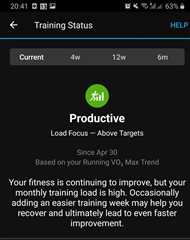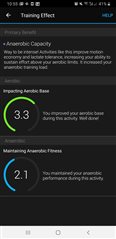Hi, all!
This is probably a question to HermanB (Firstbeat), but any insights are welcome.
The issue might not be very important in the grand scheme of things (read - F6 shortcomings and bugs), but still.
I started wearing F6 Pro in December last year (close to 24/7 since then), and it's my first Garmin wearable, so there was no previous data to transfer or synchronize. After a few trainings/workouts/runs the watch started showing all the stats, inter alia, the Optimal Range under the Load --> 7-day load. The initial Optimal Range for me was set at 722-1540 based on who knows what, and after almost half a year it is still exactly the same. It is, of course, nothing strange in itself. The thing is, though, that initially my weekly training load (TL) was more or less within that Optimal Range, sometimes going slightly above or below, and there was really no reason for the Optimal Range to jump around.
Approximately 2 months ago I started exercising more than before. I increased the duration of some runs/workouts, intensity/variety of some others, started doing new exercises, started doing more interval trainings etc. As a result my TL has increased. Typically my daily TL now is +/- 300, which means the 7-day load hovers around 2100-2200. That is 600-700 points higher than the upper limit of the Optimal Range, has been like that for quite a while, but the Optimal Range would not budge at all.


My load is above targets, but balanced.

My Training status is Productive, and has been like that since mid-March.


The watch keeps telling me that "based on your current fitness level and recent habits, your Training Load may be too high ....". I would have expected that 2 months is sufficient time for the watch/Firstbeat algorithms to recognize that the said "recent habits" have perhaps changed and adjust the Optimal Range?
Additional info in no particular order:
- For workouts (except initially back in December) I now always wear a cheststrap, OH1 or Moov so there is no inaccurate WHR data in play.
- My age/weight and activity class (currently 9) have been entered correctly.
- I use LTHR zones as automatically set up/adjusted by the watch without tinkering with anything.
- LT and VO2 max is detected during runs and updated.
- My VO2 max (for what it's worth) has gone up 2 points (meaning the Productive label is correct after all?) since mid-March and is in the Excellent range.
- After ~150 TL workouts (which sometimes takes just ~ 30 minutes, sometimes ~ 1 h or more) I am always recommended a 72 hour to 4 day (!) recovery, which seems way too much, so I no longer pay attention to that.
- My body battery (for what it's worth) rarely goes lower than 30-40 at the end of the day even with a TL of 300-400, and almost always fully recharges during the night. Generally, there is no correlation between how I feel and what the BB shows.
- Overall stress level (for what it's worth) for the past 2 months is 19.
- My weight is stable.
- My RHR is stable.
- No overtraining and no injuries during those last 2 months with increased TL.
Now, I am no athlete, and I am not training for anything specific. I just enjoy active lifestyle. I do not use Optimal Range to plan my workouts, so whether this is answered/solved or not won't change anything. At the moment a TL of ~300 (in Garmin figures) per day seems to hit the sweet spot for me, so I guess I'll keep doing what I am doing. This is all just curiosity and trying to understand weather all those fancy metrics are just another useless gimmick or if there is maybe a user error somewhere, as well as a desire to see everything work properly even if I do not use it.
So, in the end the question that I have is this.
How does the Optimal range work and what's really required to increase it? Staying above and within it does not seem to influence it. Has anybody of you, guys, managed to get the upper limit of the Optimal Range above 1540? If so, how?
Thanks!



